Skin Aging — one of the most urgent problems, which is being studied today not only by dermatologists and cosmetologists, but also by specialists in the field of molecular biology, pathomorphology, pathophysiology, genetics and other areas of medicine. The loss of physical attractiveness with age very often leads to a decrease in self-esteem and quality of life, especially in women 40-60 years old. It is this group of patients who are most interested in improving their appearance.
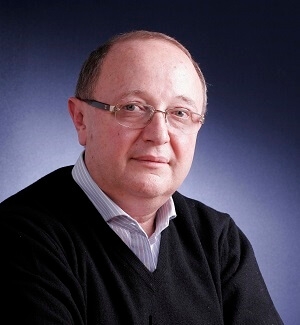
Vladimir Alexandrovich Tsepkolenko,
MD, Professor, Honored Doctor of Ukraine, President of the Ukrainian Society of Aesthetic Medicine, General Director of the Ukrainian Institute of Plastic Surgery and Aesthetic Medicine "Virtus"
Signs confirming skin aging
In most cases, the reason for the loss of attractiveness is the aging of the skin — complex multifactorial process. Natural skin aging is genetically determined and reflects general biological processes in the human body, affecting all organs and tissues. It depends on endogenous and exogenous factors, the former include changes in hormonal and immune status, chronic diseases and psycho-emotional stress, the latter — primarily ultraviolet radiation, climatic influences, nutrition and skin care. As a rule, exogenous and endogenous factors act in combination.
Involutional changes in the skin can be manifested by a number of signs: its thinning, dryness, flabbiness, decrease in elasticity and firmness, the formation of wrinkles of varying severity. Also, signs of aging include gravitational ptosis, focal and diffuse pigmentation, telangiectasias, angiomas and keratomas. The condition of aging skin can be compared with the condition of the heart muscle in angina pectoris — both develop as a result of insufficient blood flow, nutritional deficiencies, and oxygen starvation. Figuratively speaking, wrinkles — This is "angina pectoris" of the skin. Treatment of the heart muscle is aimed at restoring its normal state and functioning. So the treatment (correction) of the skin should be aimed precisely at its restoration, that is, the normalization of regeneration processes,
Thus, the regenerative component, that is, bringing the emerging dysregulatory state of the skin back to normal by influencing the key links in the pathogenesis of its aging, is put forward in the first place in the modern concept of correction of involutional changes in the skin.
MECHANISMS OF THE APPEARANCE OF A DYSREGULATORY STATE
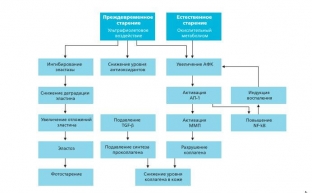
Impaired balance between prooxidant and antioxidant systems
Practically in all processes of the first level, the leading role is played by the accumulation of free radicals — reactive oxygen species (ROS). Free radicals ensure the maintenance of redox homeostasis in the body, form responses to stress, stimulate immune reactivity, participate in the regulation of membrane permeability, vascular tone, growth, differentiation, aging of cells and the body as a whole. This is the positive role of free radicals. However, imbalance between prooxidant and antioxidant systems leads to oxidative stress.When adaptive mechanisms fail, a dysregulatory pathological state develops, which is ultimately determined by the relationship between prooxidant and antioxidant mechanisms. Under the influence of various stressful stimuli, different in quality and quantity, a significant number of various antioxidants are formed in the cell, united in functional antioxidant systems (AOS).
AOCs are represented by low molecular weight compounds, which include vitamins A, C, E and K, bioflavonoids, thiols (glutathione and ergothioneine), amino acids, peptides and proteins, as well as antiperoxide enzymes (superoxide dismutase, glutathione peroxidase, glutathione reductase, catalase, etc.). ).
Thus, the balance between ROS and antioxidants is disturbed due to the age-related decrease in the volumetric blood flow velocity. This leads to a decrease in the supply of antioxidant substances and a reduction in dermal volume.
Change in dermal volume
As is known, compared with skin lesions, similar injuries of well-hydrated mucosal tissues heal faster, while the inflammatory reaction is less pronounced, and fewer scars form. Studies have found that maintaining a high level of skin hydration at all times improves skin regeneration after injury, which is similar to mucosal healing after injury.
The expression of genes depending on the state of skin hydration was studied using microarray technology. Differences in the expression of genes responsible for the production of IL-1b, IL-8, TNF-a (tumor necrosis factor-a) and COX-2 (cyclooxygenase 2) were shown in skin lesions with different levels of hydration. In an in vitro experiment, an increase in the expression of pro-inflammatory genes was observed with a decrease in the level of hydration of a human skin culture.
Hierarchical analysis of genes using RNA interference shows that both TNF-a and IL-1b regulate the expression of IL-8 through independent pathways in response to dehydration. Moreover, COX-2 inhibition has been shown to mediate TNF-a/IL-8 pathways by increasing prostaglandin E2 (PGE2) production. IL-8, in turn,
The study suggests that the level of hydration directly affects the expression of inflammatory signals in the epidermis. Thus, a decrease in the dermal volume and hydroreserve of the skin is one of the most important links in the pathogenesis and signs of age-related changes.
Hormonal and neurogenic factors significantly affect the state of vascular tone in the microvasculature. Estrogens affect the sympathetic nervous system by acting on 2-adrenergic receptors, which leads to vasospastic reactions. From a certain age in the female body there is a decrease in the production of estrogen and progesterone. As a result, the volumetric flow rate decreases. The autonomic nervous system affects the microvasculature both directly and indirectly. Normally, norepinephrine has a vasoconstrictive effect, which can act on a-1-adrenergic receptors; the vasodilating effect is characteristic of adrenaline acting on b-2-adrenergic receptors of smooth muscle cells of arterioles.
One of the causes of disruption of regional blood supply and microcirculation is endothelial dysfunction (decrease in the release of nitric oxide by the vascular wall, as well as its increased degradation, active local secretion of endothelin-1 or impaired utilization of it), which can lead to vasospasm, increased thrombus formation and increased adhesion of leukocytes to the endothelium. Vegetative dysfunctions contribute to the disruption of homeostasis and adaptation of the organism to various environmental influences. As a result of these processes, the structure of the skin is disturbed, the permeability of the vascular wall increases, the barrier functions of the epidermis decrease and conditions are created for the development of inflammation in the skin.
Thus, a decrease in blood flow is not only the most important link in the occurrence of an imbalance between ROS and antioxidants, but also leads to a decrease in the supply of nutrients to the skin, which causes structural changes in the dermis.
Impaired balance between pro-inflammatory and anti-inflammatory cytokinesWhen reactive oxygen species (ROS) appear in the skin, superoxide anion and hydrogen peroxide are produced. The number of free peroxide radicals increases, which leads to the activation of several components that transmit signals to matrix metalloproteinases (MMPs). This, in turn, stimulates the transcription of protein activator-1 (AP-1) and nuclear factor kB (NF-kB). -6, -8. The inflammation they cause leads to increased production of other cytokines and ROS. Under the action of proteases, elastin is destroyed, caused by inflammation, with the accumulation of pathological (damaged) elastin in the skin. The result of this process is the degeneration of the surrounding collagen network.
Protein activator-1 (AP-1) is involved in the stimulation of metalloproteinases in skin cells, which helps to suppress the expression of procollagen-1 genes in fibroblasts. This, in turn, causes MMP-1 (collagenase) to break down fibrillar collagen types 1 and 3. And stromelysin (MMP-3) and gelatinase (MMP-9) continue to destroy the segmented pieces of the triple helix of fibrillar collagen, ROS inactivate inhibitors of metalloproteinases. Thus, the process is looped, and the natural restoration of the skin becomes impossible.
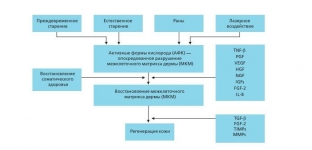
Study of skin parameters with dysregulatory condition
In UIPHiK "Virtus" a study was made of skin parameters with dysregulation conditions in patients aged 45 to 55 years. The control group consisted of healthy women aged 18 to 21.
It was found that in the dysregulated state of the skin, its hydration was lower compared to the skin of women in the control group. At the same time, the largest decrease in — by 33.3% — noted in the skin of the cheek. In the skin of the forehead, the degree of hydration decreased by 23.3%, temple — by 25.8%, chin — by 23.6%.An assessment of the morphometric parameters of the skin (table) was carried out using an ultrasound study. It was found that before the start of treatment, the thickness of the epidermis was 93.71.8 µm, the acoustic density — 92.72.9 c.u., dermis thickness — 1583.235.4 µm.
Volume blood flow velocity (Qas) before treatment was 0.0014 ml/s/cm3
in the skin of the cheek, 0.0011 and 0.0012 ml/s/cm3 in the skin of the forehead and chin, respectively.
Morphometric parameters in the group of women with involution-dystrophic skin conditions differed significantly from those in the group of practically healthy young women (aged 18 to 21 years):
epidermal thickness — 27.5% more (p<0.05);
- acoustic density — 26.4% more (p<0.05);
- dermis thickness — less by 14.3% (p<0.05).
- Thus, both the literature data and the results of our own research confirm the conclusion that the key points in the process of skin aging are:
reduction of skin hydropower;
- changes in the three-dimensional organization of the skin associated with a decrease in the level of collagen, elastin and reticulin in the dermis;
- impaired blood microcirculation in the skin;
- reduction in the number of fibroblasts and weakening of their biosynthetic activity as a result of a decrease in microcirculation and the incoming volume of nutrients.
- ALGORITHM FOR CORRECTION OF SKIN DYSREGULATORY STATES
Phase 1
Goal — diagnostics of the skin condition, identification of the patient's somatic problems.
1. Assessment of the condition of the skin, its thickness and structural elements — conducting an ultrasound examination.
2. Determination of blood flow velocity — Doppler ultrasound scan.
3. Examination of the patient (examination, history taking) in order to identify somatic problems, primarily hormonal disorders. If necessary, the patient is referred for a consultation with an appropriate specialist.
Phase 2
1. Intradermal administration of hyaluronic acid preparations — to normalize the moisture capacity of the skin.
2. Taking a skin sample from the behind the ear using the punch biopsy method for further isolation and cultivation of autologous fibroblasts in a biotechnological laboratory.
Phase 3
Goal — restoration of microcirculation and balance of pro- and anti-inflammatory systems.
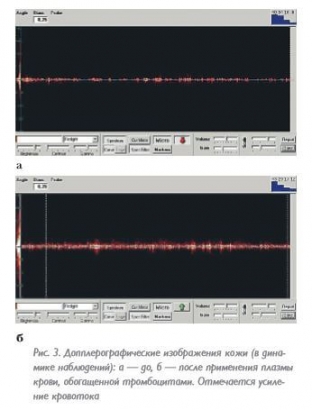 2. Performing the procedure of ablative fractional photothermolysis — to stimulate skin regeneration by creating controlled inflammation, leading to renewal of the skin microstructure.
2. Performing the procedure of ablative fractional photothermolysis — to stimulate skin regeneration by creating controlled inflammation, leading to renewal of the skin microstructure.
Stage 4
Goal — reconstruction of the microstructure of the dermis.
1. Transplantation of autologous dermal fibroblasts using intradermal injections (from 30 to 60 million once, depending on the severity of age-related changes).Note. It is at this stage, when the necessary conditions for the engraftment and functioning of fibroblasts, their introduction contributes to the formation of the extracellular matrix. This is expressed, among other things, in the production of new collagen, leading to an improvement in the appearance of aging skin.
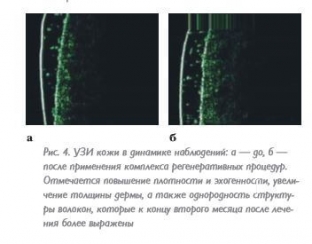
Goal — maintaining the achieved results.
Standard cosmetic skin care procedures are indicated depending on its type (and phototype), aimed at maintaining moisture capacity, dermal volume and microcirculation.
SUMMARY
The process of skin regeneration is a complex and multicomponent therapy. Correction of the skin condition with involution-dystrophic changes is based on stimulation and normalization of its ability to regenerate. The course of regenerative processes is due to many interrelated factors, which dictates the implementation of complex multicomponent therapy, which involves the consistent phased use of multidirectional methods. injection of platelet-rich plasma (PRP) into the skin to stimulate revascularization and the use of fractional photothermolysis to enhance skin regeneration.
And only after the saturation of the skin with moisture, an increase in the content of growth factors in it, it is possible to apply methods involving the introduction of autologous dermal fibroblasts. In the future, it is recommended to carry out cosmetic procedures that support the effects obtained, periodically combining them with procedures aimed at stimulating collagen synthesis.
This approach allows you to restore normal skin functions and achieve a lasting clinical effect.







Add a comment